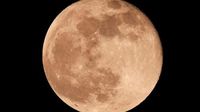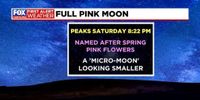As April unfolds, skywatchers are gearing up for a celestial event that promises to illuminate the night sky: the "Pink Moon." This full moon, which is set to reach its peak illumination on Saturday, April 12, 2025, at 8:22 p.m. EDT, marks the first full moon of spring and carries with it a rich tapestry of cultural significance and natural beauty.
The name "Pink Moon" may suggest a rosy hue, but in reality, the moon will not appear pink. Instead, the moniker derives from the early spring bloom of the wildflower Phlox subulata, commonly known as creeping phlox or moss phlox. This flower, which is native to eastern North America, typically bursts into bloom around the time of April's full moon, hence the name.
For those in California, the Pink Moon will reach its peak illumination at approximately 8:22 p.m. EDT, which translates to 7:37 p.m. Pacific Time. In cities like Los Angeles and San Francisco, the ideal viewing times will be around 7:26 p.m. and 7:48 p.m., respectively. Astronomers recommend finding an open area with minimal light pollution to fully appreciate the moon's glow as it rises above the horizon.
Adding to the excitement of the Pink Moon is its classification as a micromoon. This occurs when the full moon happens just before the moon reaches apogee, the point at which it is farthest from Earth. For the April 2025 Pink Moon, this apogee will occur on April 13 at 6:49 p.m. EDT, making the moon appear slightly smaller and dimmer than usual.
As the moon waxes, it currently sits in its waxing gibbous phase, boasting 90% illumination. The moon phases for April 2025 include:
- First quarter: April 4
- Full moon: April 12
- Last quarter: April 20
- New moon: April 27
April's full moon also holds significant cultural and religious importance. It is known as the Paschal Moon, which plays a crucial role in determining the date of Easter. Easter Sunday will fall on April 20, 2025, the first Sunday after the Paschal full moon, which occurs after the March equinox.
For those looking to catch other celestial events, the Lyrids meteor shower will peak on the night of April 22 and the morning of April 23, 2025. This meteor shower, which produces about 20 meteors per hour at its peak, is caused by dust particles left behind by comet C/1861 G1 Thatcher. Observers are encouraged to find dark locations after midnight for the best viewing experience.
In Wisconsin, residents may face challenges in viewing the Pink Moon due to weather conditions. The forecast predicts mostly cloudy skies with a 20% chance of rain in Milwaukee and similar conditions in Racine, Kenosha, and Madison. Despite these potential obstacles, the Pink Moon will still be a sight to behold for those fortunate enough to have clear skies.
In Texas, the Pink Moon is also expected to shine brightly, although it will not have a pink hue. Instead, it will maintain the same golden glow typical of full moons. The April full moon has been celebrated across cultures, with various names reflecting seasonal changes. For instance, in Asia, it is referred to as the “peony moon” due to the blooming of peonies during this time.
As the Pink Moon rises, it symbolizes renewal and new beginnings, a theme echoed in various cultural traditions. This year, it serves as a reminder of the beauty of spring and the cyclical nature of life.
For those interested in capturing the moment, no special equipment is needed to enjoy the Pink Moon. However, binoculars or telescopes can enhance the experience by revealing more details of the lunar surface.
The next full moon, traditionally known as the “Flower Moon,” is expected to appear on May 12, 2025, promising more opportunities for stargazers to connect with the wonders of the night sky.
As the Pink Moon approaches, enthusiasts across the country are encouraged to step outside, gaze upwards, and appreciate this remarkable natural phenomenon. Whether in California, Texas, Wisconsin, or anywhere else, the Pink Moon is a beautiful reminder of the changing seasons and the magic of the universe.










